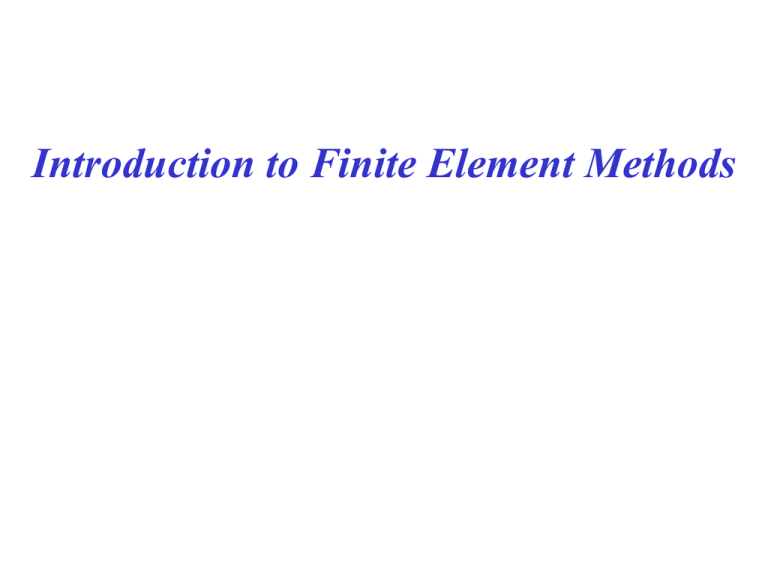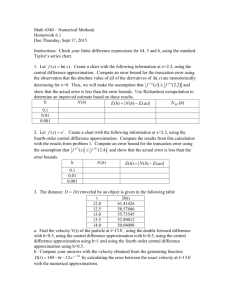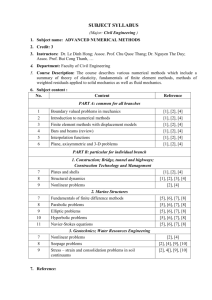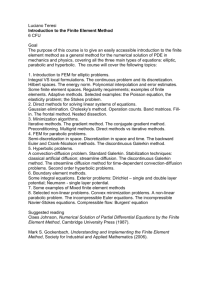FEM_Lecture (1)
advertisement

Introduction to Finite Element Methods
Need for Computational Methods
• Solutions Using Either Strength of Materials or Theory of
Elasticity Are Normally Accomplished for Regions and
Loadings With Relatively Simple Geometry
• Many Applications Involve Cases with Complex Shape,
Boundary Conditions and Material Behavior
• Therefore a Gap Exists Between What Is Needed in
Applications and What Can Be Solved by Analytical Closedform Methods
• This Has Lead to the Development of Several
Numerical/Computational Schemes Including: Finite
Difference, Finite Element and Boundary Element Methods
Introduction to Finite Element Analysis
The finite element method is a computational scheme to solve field problems in
engineering and science.
The fundamental concept involves dividing the body under study into a finite number of
pieces (subdomains) called elements
Particular assumptions are then made on the variation of the unknown dependent
variable(s) across each element using so-called interpolation or approximation functions.
This approximated variation is quantified in terms of solution values at special element
locations called nodes.
Through this discretization process, the method sets up an algebraic system of equations
for unknown nodal values which approximate the continuous solution.
Advantages of Finite Element Analysis
-
Models Bodies of Complex Shape
- Can Handle General Loading/Boundary Conditions
- Models Bodies Composed of Composite and Multiphase Materials
- Model is Easily Refined for Improved Accuracy by Varying
Element Size and Type (Approximation Scheme)
- Time Dependent and Dynamic Effects Can Be Included
- Can Handle a Variety Nonlinear Effects Including Material
Behavior, Large Deformations, Boundary Conditions, Etc.
Basic Concept of the Finite Element Method
Any continuous solution field such as stress, displacement,
temperature, pressure, etc. can be approximated by a
discrete model composed of a set of piecewise continuous
functions defined over a finite number of subdomains.
One-Dimensional Temperature Distribution
T
T
Approximate Piecewise
Linear Solution
Exact Analytical Solution
x
x
Two-Dimensional Discretization
2
1
0
u(x,y)
-1
-2
-3
4
3.5
3
Approximate Piecewise
Linear Representation
2.5
2
1.5
y
1
-1
-0.5
0
0.5
x
1
1.5
2
2.5
3
Discretization Concepts
T
Exact Temperature Distribution, T(x)
x
Finite Element Discretization
Linear Interpolation Model
(Four Elements)
T1
T2
T2
T3 T3
Quadratic Interpolation Model
(Two Elements)
T
1
T2
T4 T4
T3
T5
T
T3
T4
T5
T
T1
T1
T2
T2
T3
T4
T3
T5
T4
T5
x
Piecewise Linear Approximation
x
Piecewise Quadratic Approximation
Temperature Continuous but with
Discontinuous Temperature Gradients
Temperature and Temperature Gradients
Continuous
Common Types of Elements
One-Dimensional Elements
Line
Rods, Beams, Trusses, Frames
Two-Dimensional Elements
Triangular, Quadrilateral
Plates, Shells, 2-D Continua
Three-Dimensional Elements
Tetrahedral, Rectangular Prism (Brick)
3-D Continua
Discretization Examples
One-Dimensional
Frame Elements
Two-Dimensional
Triangular Elements
Three-Dimensional
Brick Elements
Basic Steps in the Finite Element Method
Time Independent Problems
-
Domain Discretization
Select Element Type (Shape and Approximation)
Derive Element Equations (Variational and Energy Methods)
Assemble Element Equations to Form Global System
[K]{U} = {F}
[K] = Stiffness or Property Matrix
{U} = Nodal Displacement Vector
{F} = Nodal Force Vector
- Incorporate Boundary and Initial Conditions
- Solve Assembled System of Equations for Unknown Nodal
Displacements and Secondary Unknowns of Stress and Strain Values
Common Sources of Error in FEA
• Domain Approximation
• Element Interpolation/Approximation
• Numerical Integration Errors
(Including Spatial and Time Integration)
• Computer Errors (Round-Off, Etc., )
Measures of Accuracy in FEA
Accuracy
Error = |(Exact Solution)-(FEM Solution)|
Convergence
Limit of Error as:
Number of Elements (h-convergence)
or
Approximation Order (p-convergence)
Increases
Ideally, Error 0 as Number of Elements or
Approximation Order
Two Dimensional Examples
Triangular Element
Triangular Element
Scalar-Valued, Two-Dimensional
Field Problems
Vector/Tensor-Valued, TwoDimensional Field Problems
v3
f3
u3
3
3
2
v2
f2
2
v1
1
f1
1
u2
u1
Elasticity Field Equations in Terms of Displacem ents
Example Different ial Equation :
2f 2f
f ( x, y )
x 2 y 2
Boundary Condtions Specificat ion :
df f
f
f,
nx n y
dn x
y
2 u
2 v
E
u v
Fx 0
2(1 ) x x y
E
u v
Fy 0
2(1 ) y x y
Boundary Conditons
u v
u
v
Tx C11 C12 n x C66 n y
x
y
y x
u v
u
v
T y C66 n x C12
C 22 n y
x
y
y x
Two-Dimensional Discretization Refinement
(Node)
(Discretization with 228 Elements)
(Triangular Element)
(Discretization with 912 Elements)
Development of Finite Element Equation
• The Finite Element Equation Must Incorporate the Appropriate Physics
of the Problem
• For Problems in Structural Solid Mechanics, the Appropriate Physics
Comes from Either Strength of Materials or Theory of Elasticity
• FEM Equations are Commonly Developed Using Direct, VariationalVirtual Work or Weighted Residual Methods
Direct Method
Based on physical reasoning and limited to simple cases, this method is
worth studying because it enhances physical understanding of the process
Variational-Virtual Work Method
Based on the concept of virtual displacements, leads to relations between internal and
external virtual work and to minimization of system potential energy for equilibrium
Weighted Residual Method
Starting with the governing differential equation, special mathematical operations
develop the “weak form” that can be incorporated into a FEM equation. This
method is particularly suited for problems that have no variational statement. For
stress analysis problems, a Ritz-Galerkin WRM will yield a result identical to that
found by variational methods.
Simple Element Equation Example
Direct Stiffness Derivation
u1
u2
F1
F2
1
2
k
Equilibriu m at Node 1 F1 ku1 ku2
Equilibriu m at Node 2 F2 ku1 ku2
or in Matrix Fo rm
k
k
k u1 F1
k u2 F2
Stiffness Matrix
[ K ]{u} {F }
Nodal Force Vector
Common Approximation Schemes
One-Dimensional Examples
Polynomial Approximation
Most often polynomials are used to construct approximation
functions for each element. Depending on the order of
approximation, different numbers of element parameters are
needed to construct the appropriate function.
Linear
Quadratic
Cubic
Special Approximation
For some cases (e.g. infinite elements, crack or other singular
elements) the approximation function is chosen to have special
properties as determined from theoretical considerations
Theoretical Basis: Formulating Element Equations
• Several approaches can be used to transform the physical
formulation of a problem to its finite element discrete analogue.
• If the physical formulation of the problem is described as a
differential equation, then the most popular solution method is
the Method of Weighted Residuals.
• If the physical problem can be formulated as the minimization
of a functional, then the Variational Formulation is usually
used.
Theoretical Basis: MWR
• One family of methods used to numerically solve differential equations
are called the methods of weighted residuals (MWR).
• In the MWR, an approximate solution is substituted into the differential
equation. Since the approximate solution does not identically satisfy the
equation, a residual, or error term, results.
Consider a differential equation
Dy’’(x) + Q = 0
(1)
Suppose that y = h(x) is an approximate solution to (1). Substitution then
gives Dh’’(x) + Q = R, where R is a nonzero residual. The MWR then
requires that
ò Wi(x)R(x) = 0 (2)
where Wi(x) are the weighting functions. The number of weighting
functions equals the number of unknown coefficients in the approximate
solution.
Sources of Error in the FEM
• The three main sources of error in a typical FEM solution are discretization
errors, formulation errors and numerical errors.
• Discretization error results from transforming the physical system
(continuum) into a finite element model, and can be related to modeling the
boundary shape, the boundary conditions, etc.
Discretization error due to poor geometry
representation.
Discretization error effectively eliminated.
Sources of Error in the FEM (cont.)
• Formulation error results from the use of elements that don't precisely describe the
behavior of the physical problem.
• Elements which are used to model physical problems for which they are not suited
are sometimes referred to as ill-conditioned or mathematically unsuitable elements.
• For example a particular finite element might be formulated on the assumption that
displacements vary in a linear manner over the domain. Such an element will
produce no formulation error when it is used to model a linearly varying physical
problem (linear varying displacement field in this example), but would create a
significant formulation error if it used to represent a quadratic or cubic varying
displacement field.
Sources of Error in the FEM (cont.)
• Numerical error occurs as a result of numerical
calculation procedures, and includes truncation
errors and round off errors.
• Numerical error is therefore a problem mainly
concerning the FEM vendors and developers.
• The user can also contribute to the numerical
accuracy, for example, by specifying a physical
quantity, say Young’s modulus, E, to an
inadequate number of decimal places.
Advantages of the Finite Element Method
• Can readily handle complex geometry:
• The heart and power of the FEM.
• Can handle complex analysis types:
• Vibration
• Transients
• Nonlinear
• Heat transfer
• Fluids
• Can handle complex loading:
• Node-based loading (point loads).
• Element-based loading (pressure, thermal, inertial forces).
• Time or frequency dependent loading.
• Can handle complex restraints:
• Indeterminate structures can be analyzed.
Advantages of the Finite Element Method (cont.)
•
•
•
•
Can handle bodies comprised of nonhomogeneous materials:
• Every element in the model could be assigned a different set of
material properties.
Can handle bodies comprised of nonisotropic materials:
• Orthotropic
• Anisotropic
Special material effects are handled:
• Temperature dependent properties.
• Plasticity
• Creep
• Swelling
Special geometric effects can be modeled:
• Large displacements.
• Large rotations.
• Contact (gap) condition.
Disadvantages of the Finite Element Method
• A specific numerical result is obtained for a specific problem. A
general closed-form solution, which would permit one to examine
system response to changes in various parameters, is not produced.
• The FEM is applied to an approximation of the mathematical model of
a system (the source of so-called inherited errors.)
• Experience and judgment are needed in order to construct a good finite
element model.
• A powerful computer and reliable FEM software are essential.
• Input and output data may be large and tedious to prepare and
interpret.
Disadvantages of the Finite Element Method (cont.)
• Numerical problems:
• Computers only carry a finite number of significant digits.
• Round off and error accumulation.
• Can help the situation by not attaching stiff (small) elements to
flexible (large) elements.
• Susceptible to user-introduced modeling errors:
• Poor choice of element types.
• Distorted elements.
• Geometry not adequately modeled.
• Certain effects not automatically included:
• Buckling
• Large deflections and rotations.
• Material nonlinearities .
• Other nonlinearities.
FEM in BIOMECHANICS
•
•
•
•
•
•
The process of developing finite element models begins with the acquisition of
data that will be used to define the three-dimensional geometry of the joint tissues.
These data can come from several imaging modalities, including CT and MRI.
Three-dimensional data sets are acquired and segmented, i.e., each tissue type of interest to
the modeler is labeled within the data set.
From the segmented data, three-dimensional surfaces are calculated, and fully volumetric
meshes (the geometric portion of the finite element model) are generated.
In the finite element analysis, the tissue types described by the finite element models are
assigned specific material characteristics, and the simulation is completed, with externally
calculated boundary conditions defining the specific joint behavior (e.g., flexion of the joint
due to flexor tendon action).
Each of these steps is described in more detail below and will be demonstrated.
DATA ACQUISITION
Accurate geometry is one key to successfully modeling joint behavior using finite element
techniques.
Both CT and MRI data are used in model development.
Once the data are acquired, model development is independent of the imaging modality.
Typically, scanners used in the medical field have a spatial resolution that is not acceptable
for a precise definition of articular surfaces.
A sample of high resolution
CT data, in a transverse cut through a
human hand.
Segmentation of the imaged, three-dimensional data sets is the
process of identifying tissues and their boundaries.
Edges generated by automated segmentation.
Edges filled in by automated segmentation and partially
manually corrected.
Final mask resulting from semi-automated
segmentation
SURFACE GENERATION
Three-dimensional surfaces are
generated directly from the masks
that are the final product of the
segmentation step
VOLUMETRIC MESHING
Mesh generation algorithms focus on volumetric tetrahedral meshes. The
methods used generally rely on a subdivision algorithm of the volume.
A mesh is then built by triangulating each of the cells of the volume.
Slightly changing the coordinates of the vertices helps smooth the mesh and improve
its quality.
However, tetrahedral meshes are not suited for the dynamic simulations.
Structural engineers prefer hexahedral meshes, which help speed up the
convergence of the numerical algorithms.
VISUALIZATION
Joint kinematics and tissue stresses calculated by the finite
element code are visualized on a workstation
Visualization image showing knee ligament
stresses during flexion
Bone biomechanics
Artificial Hip joint
Anatomy of Hip Joint
Largest
weight
bearing joint
Composed
of
rounded head of the
femur joining the
acetabulum of pelvis
in a ball and socket
arrangement
36
Damaged Femoral Head
Femoral head cartilage
The neck is cut-off as in
figure
Marrow cavity is made
inside the femur
Hip prosthesis is fitted
either by PMMA cement or
press fitted
37
Biomaterials
Stainless Steel Alloys
Cobalt-Chrome alloys (Vitallium)
Titanium alloys
Composites
38
Comparison of Characteristics
Characteristic
S-Steel
Co-Cr alloy
Titanium Alloy
Stiffness
High
Medium
Low
Strength
Medium
Medium
High
Corrosion -resistance
Low
Medium
High
Biocompatibility
Low
Medium
High
39
Composite Prosthesis
Clinical studies reported early fatigue
fracture of a femoral component
made from laminated fiber reinforced
composites.
The new designs are Constructed of
short glass fibers/epoxy resin and
CF/PEEK composites.
40
Composite Model
Basic Composite Model
With Elements
41
Conical Stem
Cemented prosthesis model
contains three main parts:
Conical Stem with head
Cement layer
Cortical bone
Basic Model
42
Chopped Fiber Core
Model With Chopped Fiber Core
43
Material Properties
Material Properties Used for Analysis of Total Hip Prosthesis
Parts
Material
Young’s
Modulus
(MPa)
Poisson's
Ratio
Geometrical Parameter
(All dimensions are in
mm)
Sphere radius 25
Stem radius 10
Stem outer radius 10
Stem inner radius 7.5
Inner radius 10.5
Outer radius 12.2182
Length 100
Head and
Stem
Ti6Al4V
110x103
0.33
Cement
Layer
UHMWPEAL2O3
1x103
0.39
Cortical
Bone
AS4/PEEK
3x103
0.30
Inner radius 20.5
Outer radius 30
44
Maximum Shear Stress Region
Enlarged View of the Deformed Stem and Cortical Bone Showing the
Maximum Shear Stress Region (Path Aa)
45
Variation of Shear Stresses
Variation of Maximum Shear Stress
With System Parameters
46
Stem Length
(in mm)
Maximum Shear Stress
(in MPa)
Neck Length
(in mm)
Maximum Shear Stress
(in MPa)
145
17.314
45
13.337
145.5
15.522
47.5
17.376
147.5
21.033
150
20.919
50
17.314
152.5
17.144
52.5
25.363
155
20.262
Neck Inclination
(in degree)
Maximum Shear Stress
(in MPa)
Stem Inner Radius
(in mm)
Maximum Shear Stress
(in MPa)
45
17.314
7.5
17.314
47.5
20.383
8
20.655
50
22.964
8.5
19.443
Continued...
The variation in
the above
parameters do not show a particular
trend
Hence the design optimization has
been carried out to minimize the
magnitude of maximum shear stress
47
Hip Prosthesis
Dimensions of Hip Prosthesis Before Optimization
Parts
State Variables
Sphere Radius
25 mm
Femur
Neck
Inclination
48
Design Variables
Stem Outer
Radius
10 mm
Stem Inner
Radius
7.5 mm
Stem Length
145.5 mm
Neck length
50 mm
450
Femoral Components
Design Variables of Femoral Components
After Optimisation
49
Design Variables
Dimension (mm)
Stem outer radius
9.9301
Stem inner radius
8.0405
Stem length
153.22
Neck length
50.975
Shear Stresses
SXY
x-y component
SYZ
y-z component
SXZ
z-x component
Shear Stresses in the Interface of Stem and Cortical Bone
50
Shear Stresses - Continued…
SXY
x-y component
SYZ
y-z component
SXZ
z-x component
51
Shear Stresses in the Interface of Stem and Cortical Bone
Dentistry
Lumbar disc degeneration
Neck Injury Prevention
Experimental Research and Development
Neck Injury Prevention
Existing numerical models of the cervical musculatu
Eindhoven (MADYMO)
(Van der Horst 2002)
Duke (LS-DYNA)
(Chancey et al. 2003)
France (RADIOSS)
(Frechede et al. 2006)
JAMA (LS-DYNA)
(Ejima et al. 2005)
KTH (LS-DYNA)
(Brolin et al. 2005)
Numerical Modeling
The KTH FE Neck Model
Intervertebral
Disks and
Ligaments
Vertebrae
Muscles
Geometry of the Cervical Musculature
The FE Muscle Model Geometry created from
MRI
1. Segmented from MRI
(50th percentile)
2. Interpolated into 3D
surfaces
Geometry of the Cervical Musculature
The FE Muscle Model Geometry created from
MRI
1. Segmented from MRI
(50th percentile)
2. Interpolated into 3D
surfaces
3. Positioned relative the
KTH neck model in
line with the literature
Geometry of the Cervical Musculature
The FE Muscle Model Geometry created from
MRI
•
25 individual muscle pairs
•
Rigid body insertions to the
vertebrae
•
One muscle can have multiple
origins/insertions
Geometry of the Cervical Musculature
Anterior: Hyoid, SCM
Posterior: TZ, SplCap
Lateral: SCM, TZ
Posterior: Suboccipital
Evaluation of Muscle Models
Discrete Muscle Model
DMM
Continuum Muscle Model
CMM
SMFE Muscle Model
SMFEMM
Evaluation of Muscle Models
Rear end ~4G
[Ono et al 1999 and Davidsson et al
1999]
Evaluation of Muscle Models
Frontal~15G
[Ewing et al 1977]
Lateral ~7G
[Ewing et al 1977]
Heart and FEM
Finite Element Modeling of the
Human Foot and Footwear








